#chaos ad
Explore tagged Tumblr posts
Photo
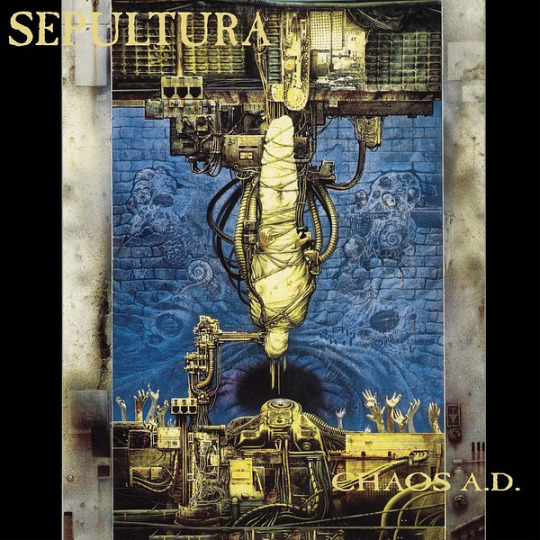
nowplaying Refuse / Resist by Sepultura out of Chaos A.D. (Expanded Edition)
2 notes
·
View notes
Text
“jason is so cold and inconsiderate” his natural instinct when he found out nico was staying at camp was to hug him tightly but he restrained himself because nico mentioned to jason ONCE that he doesn't like being touched. consent KING
#all you haters do is yap yap yap are y'all getting paid to hate jason lol bc the slander is SO forced and artificial imo#just adding that he had no reason to remember nico said that.#especially after the string of chaos that took place AFTER it would've made what nico said forgettable considering the war and stuff#losing leo too took a huge toll on his mental health#but jason still remembered. very demure and mindful of him#pjo#pjo fandom#percy jackson#pjo series#pjo hoo#jason grace#pjo hoo toa#hoo fandom#hoo series#heroes of olympus#nico di angelo
3K notes
·
View notes
Text
marvel writers: "okay aubrey, we need you to ad lib a line for rio, just keep it light and fun, okay? don't egg-on the lesbians.. "
this freak:

#agatha spoilers#agatha defender#rio vidal x agatha harkness#rio x agatha#agatha harkness x rio vidal#agathario#agatha x rio#agatha coven of chaos#agatha all along#agatha harkness#rio vidal#aubrey plaza#marvel#kathryn hahn#I don't know if it was really ad lib but I hope it was!
1K notes
·
View notes
Text
1 note
·
View note
Text
Nublar 5 shenanigans



#jwct#jurassic world chaos theory#yasmina fadoula#kenji kon#ben pincus#darius bowman#nublar five#i hate kenji so much#it pained me to draw him#(hes just fugly)#i love you yas#ben my son#why is he so buff#added scars but im not a jwct maniac so idk if theyre accurate
275 notes
·
View notes
Text

still need to make proper reference sheets for my hms designs. more soul for the soul
#chonnys charming chaos compendium#chonny jash#cccc soul#cj soul#art#my art#ouh i love asymmetry. ouh i loooove adding chains everywhere for no reason#oooouuuuhhhhhh i loooooove making detailed designs
321 notes
·
View notes
Text

A perky panpiper, one of the more cheerful characters traveling the planes from Sigil (Tony DiTerlizzi, AD&D 2e Planescape Campaign Expansion Planes of Chaos: The Travelogue, TSR, 1994)
#D&D#Dungeons & Dragons#Tony DiTerlizzi#Planescape#tiefling#satyr#faun#dnd#panpipes#pan flute#AD&D#AD&D 2e#D&D 2e#Planes of Chaos#TSR#1990s
300 notes
·
View notes
Text

sweet baby… this was so so so fun to draw. shoutout to the tens of vintage shaving cream ads i combed through to reference this
prints
#bordel is french slang for chaos#giggling and kicking my legs#fruitgravy#digital art#procreate#aesthetic#illustration#character art#character design#oc#original character#moonie’s ocs#original characters#orignal oc#original comic#vintage art#vintage aesthetic#vintage#vintage ads#vintage advertising#magazine#mafia oc#oc artist#art#artist support#concept art#artwork
642 notes
·
View notes
Text
Cold Iron in folklore, fiction, and RPGs
'Gold is for the mistress—silver for the maid! Copper for the craftsman cunning at his trade.' 'Good!' said the Baron, sitting in his hall, 'But Iron—Cold Iron—is master of them all!' — Rudyard Kipling, “Cold Iron”
Folklore

Drudenmesser, or "witch-knife", an apotropaic folding knife from Germany
The notion that iron (or steel) can ward against evil spirits, witches, fairies, etc is very widespread in folklore. You hang a horseshoe over your threshold to deny entry to evil spirits, you carry an iron tool with you to make sure devils won't assault you, you place a small knife under the baby's crib to ward it from witches, and so on. Iron is apotropaic in many many cultures.
In English, we often come across passages that refer to apotropaic cold iron (or cold steel). "All uncouth, unknown Wights are terrifyed by nothing earthly so much as by cold Iron", says Robert Kirk in 1691, which I believe is the earliest example. "Evil spirits cannot bear the touch of cold steel. Iron, or preferably steel, in any form is a protection", says John Gregorson Campbell in 1901.
Words
So what is cold iron? In this context, it’s just iron. The “cold” part is poetic, especially – but not only – if we’re talking about either blades (or swords, weapons, the force of arms) or manacles and the like. It just sounds more ominous. There are “cold yron chaines” in The Fairie Queene (1596), and a 1638 book of travels tells us that a Georgian general (in the Caucasus) vowed “to make the Turk to eat cold iron”.
Green’s Dictionary of Slang defines “cold iron” as a sword, and dates the term to 1698. From 1725 it appears in Cant dictionaries (could this sense be thieves’ cant, originally? why not, plenty of words and expressions started as underworld slang and then entered the mainstream), and from ~1750 its use becomes much more common.
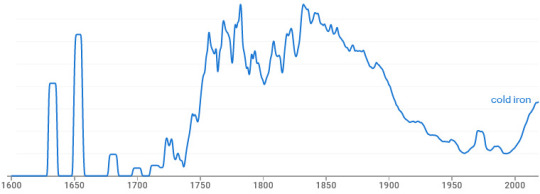
NGram Viewer diagram for 1600-2019.
In other contexts, cold iron is (surprise!) iron that’s not hot. So let’s talk a bit about metallurgy.
Metals

In nature, we can find only one kind of iron that’s pure enough to work with: meteoritic iron. It has to literally fall from the sky. Barring that very rare occurrence, people have to mine the earth for iron ore, which is not workable as is. To separate the iron from the ore we have to smelt it, and for that we need heat, in the form of hot charcoals. Throwing the ore on the coals won’t do much of anything, it’s not hot enough. But if we enclose the coals in a little tower built of clay, leaving holes for air flow, the temperature rises enough to smelt the ore. That’s called a bloomery.
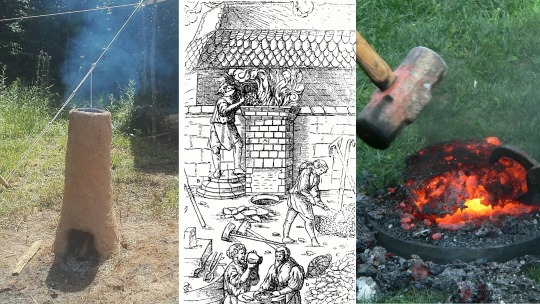
clay bloomery / medieval bloomery / beating the bloom to get rid of the slag
What comes out of the bloomery is a bloom: a porous, malleable mass of iron (that we need) and slag (byproducts that we don’t need). But now we can get rid of the slag and turn the porous mass to something solid, by hammering the hot bloom over and over. And once the slag is off, by the same process we can give it a desired shape in the forge, reheating it as needed. This is called “working” the iron, hence “wrought iron” objects, i.e. forged.
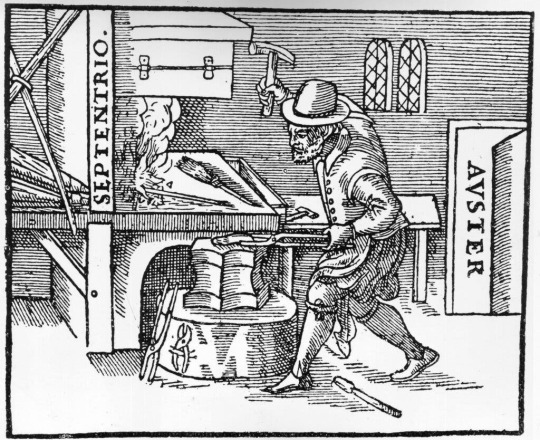
a blacksmith in his forge, with bellows, fire, and anvil (English woodcut, 1603)
This is the lowest-tech version, possibly going back to ~2000 BCE in Nigeria. If we add bellows, the improved air flow will raise the temperature. So smelting happens faster and more efficiently in the bloomery, and so does heating the iron in the forge, making it easier to work with. And that’s the standard process from the Iron Age all through the middle ages and beyond (although in China they may have skipped this stage and gone straight to the next one).
If we make the bloomery bigger and bigger, with stronger and stronger bellows, we end up with a blast furnace, a construction so efficient that the temperature outright melts the iron, and it’s liquified enough to be poured into a mould and acquire the desired shape when it cools off. This is “cast iron”.

a blast furnace
So in all of this, what’s cold iron? Well, it’s iron that went though the heat and cooled off. (No heat = no iron, all you got is ore.) If it came out of a bloomery, or if it wasn’t cast, it’s by definition worked, hammered, beaten, wrought, and that happened while it was still hot.
Is there such a thing as “cold-wrought” iron? No. In fact, “working cold iron” was a simile for something foolish or pointless. A smith who beats cold iron instead of putting it in the fire shows folly, says a 1694 book on religion, so you too should choose your best tools, piety and good decorum, to educate your children and servants, instead of beating them. When Don Quixote (1605) declares he’ll go knight-erranting again, Sancho Panza tries to dissuade him, but it’s like “preaching in the desert and hammering on cold iron” (a direct translation of martillar en hierro frío).
Minor work can be done on cold iron. A 1710 dictionary of technical terms tells us that a rivetting-hammer is “chiefly used for rivetting or setting straight cold iron, or for crooking of small work; but ’tis seldom used at the forge”. Fully fashioning an object out of cold iron is not a real process – though a 1659 History of the World would claim that in Arabia it’s so hot that “smiths work nails and horseshoes out of cold iron, softened only by the vigorous heat of the sun, and the hard hammering of hands on the anvil”. [I declare myself unqualified to judge the veracity of this statement, let's just say I have doubts.] And there is of course such a thing as “cold wrought-iron”, as in wrought iron after it’s cooled off.
Either way, in the context of pre-20th century English texts which refer to apotropaic “cold iron”, it’s definitely not “cold-wrought”, or meteoritic, or a special alloy of any kind. It’s just iron.
Fiction
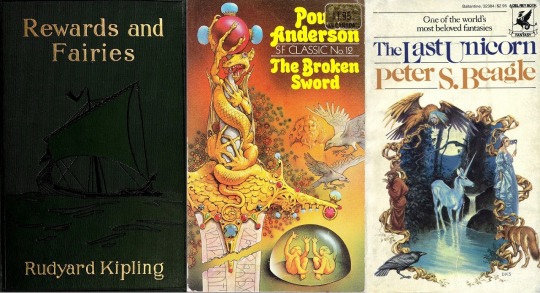
The old superstition kept coming up in fantasy fiction. In 1910 Rudyard Kipling wrote the very influential short story “Cold Iron” (in the collection Rewards and Fairies), where he explains invents the details of the fairies’ aversion to iron. They can’t bewitch a child wearing boots, because the boots have nails in the soles. They can’t pass under a doorway guarded by a horseshoe, but they can slip through the backdoor that people neglected to guard. Mortals live “on the near side of Cold Iron”, because there’s iron in every house, while fairies live “on the far side of Cold Iron”, and want nothing to do with it. And changelings brought up by fairies will go back to the world of mortals as soon they touch cold iron for the first time.
In Poul Anderson’s The Broken Sword (1954), we read:
“Let me tell you, boy, that you humans, weak and short-lived and unwitting, are nonetheless more strong than elves and trolls, aye, than giants and gods. And that you can touch cold iron is only one reason.”
In Peter S. Beagle’s The Last Unicorn (1968) the unicorn is imprisoned in an iron cage:
“She turned and turned in her prison, her body shrinking from the touch of the iron bars all around her. No creature of man’s night loves cold iron, and while the unicorn could endure its presence, the murderous smell of it seemed to turn her bones to sand and her blood to rain.”
Poul Anderson would come back to that idea in Operation Chaos (1971), where the worldbuilding’s premise is that magic and magical creatures have been reintroduced into the modern world, because a scientist “discovered he could degauss the effects of cold iron and release the goetic forces”. And that until then, they had been steadily declining, ever since the Iron Age came along.
There are a million examples, I’m just focusing on those that would have had a more direct influence on roleplaying games. However, I should note that all these say “cold iron” but mean “iron”. Yes, the fey call it cold, but they are a poetic bunch. You can’t expect Robin Goodfellow’s words to be pedestrian, now can you?
RPGs
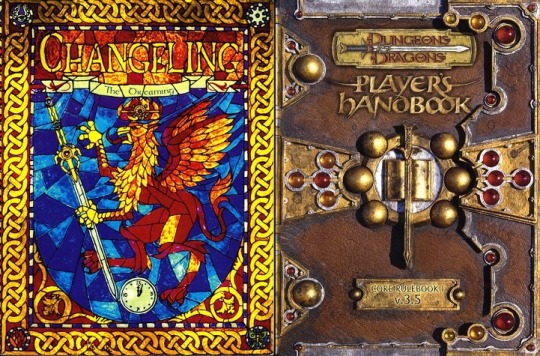
And from there, fantasy roleplaying systems got the idea that Cold Iron is a special material that fey are vulnerable to. The term had been floating around since the early D&D days, but inconsistently, scattered in random sourcebooks, and not necessarily meaning anything else than iron. In 1st Edition’s Monster Manual (1977) it’s ghasts and quasits who are vulnerable to it, not any fey creature. Devils and/or fiends might dislike iron, powdered cold iron is a component in Magic Circle Against Evil, and “cold-wrought iron” makes a couple of appearances. For example, in AD&D it can strike Fool’s Gold and turn it back to its natural state, revealing the illusion.
Then Changeling: The Dreaming came along and made it a big deal, a fundamental rule, and an anathema to all fae:
Cold iron is the ultimate sign of Banality to changelings. ... Its presence makes changelings ill at ease, and cold iron weapons cause horrible, smoking wounds that rob changelings of Glamour and threaten their very existence.... The best way to think about cold iron is not as a thing, but as a process, a very low-tech process. It must be produced from iron ore over a charcoal fire. The resulting lump of black-gray material can then be forged (hammered) into useful shapes. — Changeling: The Dreaming (2nd Edition, 1997)
So now that we know how iron works, does that description make sense? Well, if we assume that the iron ore is unceremoniously dumped on coals, it does not. You can’t smelt iron like that. If we assume that a bloomery is involved even though it’s not mentioned, then yes, this is broadly speaking how iron’s been made since the Iron Age, and until blast furnaces came into the picture. But the World of Darkness isn’t a pseudo-medieval setting, it’s modern urban fantasy. So the implication here is that “cold iron” is iron made the old way: you can’t buy it in the store, someone has to replicate ye olde process and do the whole thing by hand. Now, this is NOT how the term “cold iron” has been used in real life or fiction thus far, but hey, fantasy games are allowed to invent things.
Regardless, 3.5 borrowed the idea, and for the first time D&D made this a core rule. Now most fey creatures had damage reduction and took less damage from weapons and natural attacks, unless the weapon was made of Cold Iron:
“This iron, mined deep underground, known for its effectiveness against fey creatures, is forged at a lower temperature to preserve its delicate properties.” — Player’s Handbook (3.5 Edition, 2003)
Pathfinder kept the rule, though 5e did not. And unlike Changeling, this definition left it somewhat ambiguous if we’re talking about a material with special composition (i.e. not iron) or made with a special process (i.e. iron but). The community was divided, threads were locked over this!
So until someone points me to new evidence, I’ll assume that the invention of cold iron as a special material, distinct from plain iron, should be attributed to TTRPGs.
#long post#cold iron#d&d#Changeling: The Dreaming#World of Darkness#Peter S. Beagle#The Last Unicorn#Rudyard Kipling#Poul Anderson#The Broken Sword#how to rogue#pathfinder#rogues in fiction#Operation Chaos#rogue superstitions#words of the trade#thieves' cant#ad&d#d&d history#1st edition#fey#3.5#fluff#trs
405 notes
·
View notes
Text








GMMTV Outing 2024 out of context (not that it would make more sense with context) - part 2
#gmmtv#gmmtv outing 2024#the chaos of joong in his mermaid suit djkhfd i cant stop laughing#dunk dragging him across the floor and everyone just giving up at the end#also the second one with phuwin and nanon has vine energy and im living for it#even my markohm made an appearance 🥹#incredible#wish i was there#or#do i#kjdshfkd#debatable#also i apologize for the quality but yknow how it is lmao rip#i cant#*edit: adding descriptions to this one as well (from top left to bottom right)#1: Jan in some anime cosplay#2: phuwin getting lipgloss put on him while nanon looks confused and done w/ everything#3: Lady Off fixing her hair#4: dunk dragging mermaid joong across the floor#5: markohm twerking on each others asses#6: someone twerking#7: mermaid joong laying on dunks lap#8: fourth (and others) casting a spell in a hogwarts outfit and superman!mark jumping out scaring them
218 notes
·
View notes
Photo

#cacophony#michael whelan#art#artwork#painting#chaos ad#Illustration#surrealism art#surrealism#sepultura#chaos .a.d.#chaos a d
110 notes
·
View notes
Text
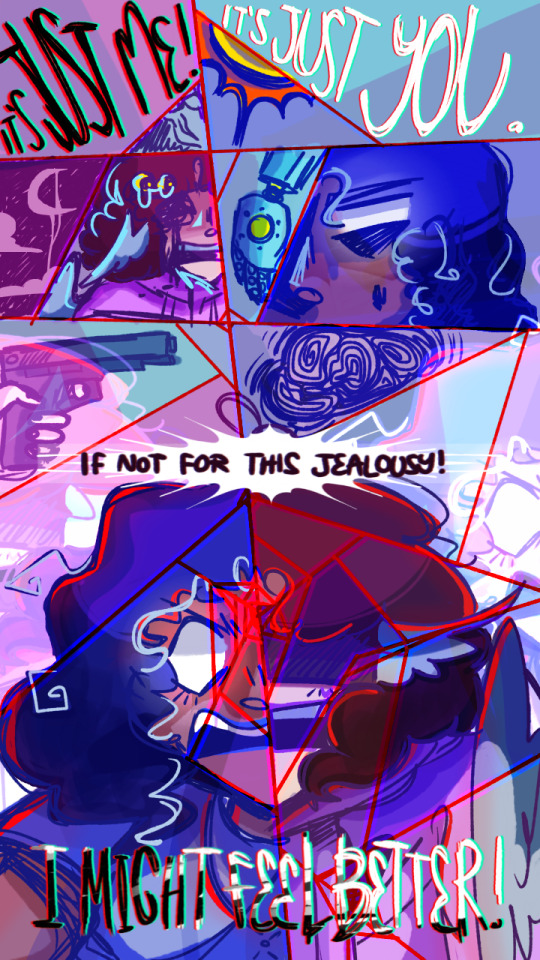
EAT YOUR FRIENDS.
#ah I love this song🥰🥰#and depictions of glass breaking in hms art 🥰🥰🥰🥰#I also gave mind grey hairs because of course it would have grey hairs and i was stupid for not adding it to my reference sheet#like i was so envious of white hair mind designs but i didn't want to draw him with white hair for some reason but like!!!#The solution!!! Gray hairs!!!#neon's nonsense#chonny jash#chonnys charming chaos compendium#cj mind#cccc#cccc fanart#cccc mind#cccc heart#cj heart#just realised i forgot Heart's lipstick in the small heart drawing under the “its just me” bit and i can't be bothered to fix it#that will irk me
328 notes
·
View notes
Text

#spm#super paper mario#super dimentio#Dimentio#luigi#smb#the chaos heart#< how is that not a tag#super mario#super mario bros#Adding relevant tags for reach is annoying who does this shit#front soup.txt#heyyy the adding tags is only annoying on our tablet actually jsyk#maybe if you found a way to change the tablets keyboard to mimic computer keyboard clicking you'll like it?#the problem is the tablet feels heavy eith how we hold it. not the sound. but the sound could be improved
81 notes
·
View notes
Text



Andrew Garfield for BuzzFeed UK
#this interview was pure chaos and the way they added these zoomed in moments only added to it#andrew garfield#my gifs#I recommend watching this cause it was great and with Florence Pugh too#I love the way his face does things#and this very unbuttoned shirt showing more of his neck/shoulder hello?? it's like it was designed to bother me#I am definitely bothered#his silly nature and his beautiful face and his insightful thoughts have bewitched me
75 notes
·
View notes
Text
bpd soul propaganda
his relationships with heart and mind are extremely tumultuous. he alternates between encouraging support and harsh criticism. he wants them to be close and loves them, but he's easily frustrated by their conflict and despises them for it.
he seeks a stability that seems impossible for him to achieve. when he doesn't feel like he can be stable, he threatens suicide because it feels like his only option. suicidal and self-destructive behavior is really common in bpd, especially in response to interpersonal distress and instability.
he has very little sense of self. identity isn't something he feels like he has the right to have (since personal separation is contradictory to trying to be Whole), but also, it seems like something he just can't get a grip on even if he tried.
I think that he has extreme attachment issues in concord. he's terrified that things will go wrong again, worried one of them will get hurt or disappear whenever he's not keeping an eye on them. he wants to know exactly where they are and be told when they're leaving because otherwise he'll panic about their absence.
on that note, his fears of hurting them or ruining things when things seem stable are something a lot of people with bpd struggle with. there's this underlying fear that the things "inherently wrong with you" will ruin everything you touch, either because of personal experience or internalized demonization.
if you headcanon Whole as a distinct person, that would be his favorite person. the extreme, almost religious idealization and having your entire sense of self revolving around a person (or really, the perception of perfection you have of a person) is a clear sign of having a favorite person. the abandonment issues would also be the worst with Whole, for obvious reasons
also i think it would be neat if this was a more widespread concept
#maintagging this. please be niceys#cccc#chonny jash#chonnys charming chaos compendium#cj soul#cj whole#(mentioned)#i'm not adding citations to this one since this is mostly headcanon and also i'm not at home rn#this is my self indulgent interpretation. i beg you to humble me etc etc#tridential tirade#sui mention#(par for the course for cccc but jic)
81 notes
·
View notes
Text

spitfire study sketches! ^.^
#earthspark spitfire#chaos terran spitfire#transformers earthspark spoilers#earthspark#tfe spitfire#fleshandwires art#WHY IS SHE SO DIFFICULT TO DRAWWW. (< says this about every character ever)#daughter beloved im lauching your stupid helm into the sun i dont like it#added some notes for myself for twitch and spitfire but hmmm. i dont like how i drew twitch that much. augh.#i fucked up her colors whoops;; can we get a 2d render of her pls pls
113 notes
·
View notes